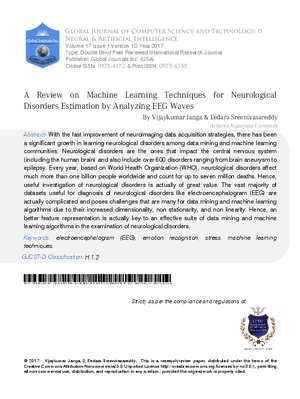Abstract
With the fast improvement of neuroimaging data acquisition strategies there has been a significant growth in learning neurological disorders among data mining and machine learning communities Neurological disorders are the ones that impact the central nervous system including the human brain and also include over 600 disorders ranging from brain aneurysm to epilepsy Every year based on World Health Organization WHO neurological disorders affect much more than one billion people worldwide and count for up to seven million deaths Hence useful investigation of neurological disorders is actually of great value The vast majority of datasets useful for diagnosis of neurological disorders like electroencephalogram EEG are actually complicated and poses challenges that are many for data mining and machine learning algorithms due to their increased dimensionality non stationarity and non linearity Hence an better feature representation is actually key to an effective suite of data mining and machine learning algorithms in the examination of neurological disorders With this exploration we use a well defined EEG dataset to train as well as test out models A preprocessing stage is actually used to extend arrange and manipulate the framework of free data sets to the needs of ours for better training and tests results Several techniques are used by us to enhance system accuracy This particular paper concentrates on dealing with above pointed out difficulties and appropriately analyzes different EEG signals that would in turn help us to boost the procedure of feature extraction and enhance the accuracy in classification Along with acknowledging above issues this particular paper proposes a framework that would be useful in determining man stress level and also as a result differentiate a stressed or normal person subject
This work is licensed under a Creative Commons Attribution 4.0 International License.
Copyright (c) 2017 Authors and Global Journals Private Limited

